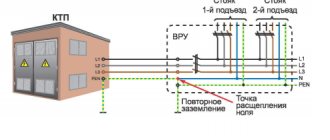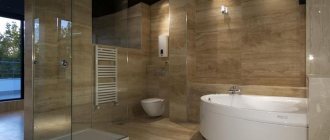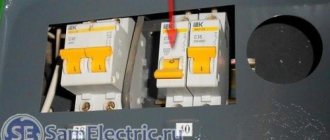Electrician in the house
Encyclopedia about electricity from A to Z
Masters catalog
Find the best master or company in your city
Entrance lighting
Lighting in the entrances of residential buildings is quite an overhead item for any community of homeowners. Therefore, the question of saving on this type of expense is raised quite often.
Some people reduce the light level by unscrewing some of the lamps, while others optimize the control circuit. We will talk about the possibilities of such optimization in our article.
- Requirements for the level and method of controlling illumination of entrances Standards of illumination of various parts of the entrance and utility rooms
- Standards for controlling entrance lighting
- Lighting control using push-button stations
Reasons for popularity
Lamps with a built-in motion sensor are very popular today and are actively used in various rooms.
It is especially rational to use them in the entrances of multi-storey buildings. It is here that such lamps are not luxury items, as in apartments, but an urgent necessity. This is due to the fact that lamps with a motion sensor make it possible to save a lot on energy consumption, as well as fully fulfill their functional purpose - to provide lighting at the required level. The reasons for using lamps in the entrance that have a sensor in their design that reacts to movements lie in the fact that people visit this room periodically, but it is quite dark. Therefore, a lighting device is needed here that will react only to the appearance of a person, and not shine all the time. This will ensure that the light turns on only when necessary. Such automatic lighting will completely satisfy a person in lighting, and in the absence of movement, the built-in sensor will turn off the light as unnecessary. Lamp in the entrance
Thus, lamps with a built-in motion sensor are the most rational devices of this kind for creating lighting in the entrance. The light will turn on only when necessary - when a person moves along the staircase or front door.
Modern technical solutions
Trends towards economical use of electricity are forcing us to abandon the usual incandescent lamps, and are inclined to choose modern LED and fluorescent lamps. Their high efficiency and low energy consumption make them indispensable for use in housing and communal services lamps. The money spent on the purchase of fluorescent or LED lamps is repaid by their long service life. They do not heat up, which means they fail much less often, which indicates their higher reliability.
Fluorescent lamps create a diffused stream of light, which can be successfully used to illuminate large areas, such as parking lots, basements or attics. LED lamps are the most environmentally friendly type of lighting. They do not contain any harmful materials.
Nuances of lighting control
Changes and improvements in the technical component of lighting are happening quite quickly. Regulations cannot change so quickly, so they may not always provide specific guidance regarding the installation of equipment in entryways. Therefore they can provide general rules. For example, according to the building code instructions for any lighting system, even if it turns on and off automatically, there must be an additional way to force it to turn off the power. Such a device may be necessary during rescue or repair operations.
The automation system for lighting in the entrances of residential buildings must operate without failures and turn on devices simultaneously in all rooms that are related to the entrance. This should happen without any time delays. In some cases, an additional module in the form of a photo relay or time sensor is used for this. An integral part is emergency lighting. It should turn on simultaneously with the entire system, but if the sensors fail, it should be possible to start it in emergency mode from a manual switch.
What the law says about lighting the local area of an apartment building
adjoining
It includes all land plots near the house (both private and multi-apartment), regulated by the right of ownership or use of the site and intended for servicing the house, namely:
- Ground under the building.
- Walkways and sidewalks, playgrounds, lawns and flower beds.
- Areas for recreation and sports.
- Car parking.
- Reasons for economic needs.
Knowing what the territory of the house is and what its boundaries are, residents can protect themselves from illegal buildings inside their yard (kiosks, counters).
Such territories must necessarily have demarcated areas. For such cases, geodesy is used. Geodesy (surveying) is a method of establishing the boundaries of a piece of land using surveying methods. It includes a set of works to determine and secure the boundaries of the area and its territory. An understanding of what land management is will be required when legalizing documents for a land plot.
Requirements for organizing yard lighting
Such requirements are contained in the Housing Code of the Russian Federation, as well as other legal sources:
- Federal Law No. 131-FZ.
- Decree of the Government of the Russian Federation of August 13, 2006 No. 491.
- Letter of the Ministry of Construction of Russia dated September 18, 2017 No. 33418-ACh/04.
A business license number is required for many businesses before they begin operating. Others can get by with just a tax identification number. It depends on the city, the subject of the Russian Federation, where it is formed and operates, as well as on the type of business.
Several factors come into play when determining whether a business requires a license or tax identification number. In many cases, both may be needed. Familiarization with this requirement is just one of many steps an entrepreneur must take when starting a business.
If an organization falls into a specific industry, it has federal licensing requirements in addition to the requirements of the constituent entity of the Russian Federation.
Punishments range from taxes and fees to business takeover and closure. Many organizations skip one license or another. For example, many local businesses apply for state registration but are unable to register the country and may receive tax notices with penalties for unpaid taxes. Those who fail to comply with federal standards may face business closure and the possibility of facing criminal and civil lawsuits.
A legally registered company is not difficult to verify using electronic systems or when contacting a government agency (tax services, Rosportebnadzor).
In their activities, such offices must be guided exclusively by sources of Russian law. The state imposes the following requirements for lighting the local area of an apartment building:
- Each building entrance must be equipped with at least 1 lantern.
- Nearby roads, paths and entrances to the territory must also be illuminated within the established standards (the style and shape of the devices can be chosen by the utility organization).
- Using poles with lanterns, it is necessary to create lighting for playgrounds, parking lots and sidewalks.
Turning on/off lighting devices is the responsibility of employees of authorized organizations (service providers). Mandatory requirements for companies also include mandatory interaction with local government and municipal authorities.
Responsibilities include reviewing written correspondence, obtaining various clarifications, and fulfilling requests. Organizations also enter into contracts for the provision of services. If they have a license, companies have the right to participate in procurement and bidding.
Such services are often provided by LLCs (limited liability companies) and JSCs (joint stock companies). The regulatory services in the Russian Federation - Rospotrebnadzor, housing inspections, municipalities, law enforcement agencies, and the prosecutor's office - are always interested in their quality.
Lighting in the basement
There are special requirements for organizing basement lighting due to the special microclimate inside the room. As a rule, it is always humid there and dampness may occur, so lamps must meet electrical and fire safety standards.
The power must be reduced to 42 W using a step-down transformer. The lamp body must be grounded. When laying cables, it is not recommended to connect copper and aluminum wires, which react when exposed to moisture. The wiring is placed in special corrugated pipes called a sleeve.
To illuminate underground spaces, it is recommended to take a lamp with a protection level of at least IP 44, this will prevent dust and moisture from entering the lamp. The illumination standard for the basement is 20 Lux.
Requirements for the level and method of controlling illumination of entrances
Lighting standards for various parts of the entrance and utility rooms
Before moving on to questions about the possibility of automating lighting control systems, you should understand the standards required by various regulations for this parameter. After all, this will allow us not only to arrange our lamps as efficiently as possible, but will also give us the opportunity to use the optimal automation system in our case.
- As you already understand, GOST entrance lighting has a different standard for different rooms. It is standardized in Table 1 VSN 59 - 88. According to this standard, two types of illumination are distinguished - illumination from fluorescent lamps and incandescent lamps. By the way, the so-called energy-efficient lamps are fluorescent.
- First of all, let's look at staircases and floor corridors. The illumination of these areas when using fluorescent lamps should be 10 lux, but if incandescent lamps are used, then the norm is 5 lux. In this case, the standardization plane is the steps and the floor of the corridor.
Requirements for entrance lighting
- GOST for lighting of entrances with elevators is somewhat different. Thus, elevator halls should have an illumination of 20 lux when using fluorescent lamps and 7 lux for incandescent lamps. At the same time, according to clause 2.27 of VSN 59 - 88, the lamp must be installed in such a way that part of the luminous flux is directed towards the elevator doors. The lighting of entrance halls must meet similar requirements.
- If there are wheelchair spaces at the entrance, they should be illuminated using incandescent lamps. In this case, the standard illumination for them is 20 lux, and the normalized surface is the floor.
- Elevator shafts, if they are not made with mesh fencing, must also have lighting. For them, the norm is 5 lux and is given only for incandescent lamps. In this case, a conventional surface three meters from the lamp is taken as the standardized surface.
- GOST lighting for entrances must also correspond to rooms such as a basement or attic. It is recommended to use only incandescent lamps for them. The lighting standard is 10 lux. In this case, not the entire room should be illuminated, but only the main passages. The same standards apply to garbage collection chambers, electrical switchboards and other similar premises.
Standards for controlling entrance lighting
Automatic lighting in entrances is constantly being modernized. More and more complex and energy-efficient schemes are emerging, and regulations do not always keep up with these changes.
Therefore, for the most part, they are advisory in nature and place all responsibility on the house design. At the same time, there are certain points that must be taken into account when designing.
Entrance lighting standards
So:
- First of all, it should be remembered that, according to clause 8.1 of VSN 59 - 88, with any method of lighting automation it must be possible to turn it on manually at any time of the day. This is necessary both for repair work and for various unforeseen situations.
- When installing automation systems that respond to room illumination, timely switching on of lighting for rooms with different natural light levels must be provided. This can be achieved by turning on all the lights when the light level is reduced in the darkest place, or by installing additional light sensors.
- When using various sensors, evacuation or emergency lighting must be provided, which is turned on by a regular switch in addition to the automation. With the onset of darkness, it should be constantly on.
- According to clause 8.15 of VSN 59 - 88, switching devices for turning on the attic lighting must be located outside this room. They are usually located at the entrance. If there are several such inputs, then a switching device must be installed on each one.
- All lighting switching devices must ensure that the phase wire is broken. In this case, the presence of phase must be ensured on the secondary circuits of the lighting control system.
Understanding the requirements
If a multi-storey building is owned by a certain service that maintains it, then you can’t just go and install the lighting that you like the most. There are certain standards that regulate and standardize lighting in the entrance of an apartment building. They cannot be neglected. According to GOST standards, the lighting requirements for different rooms differ. This depends on the area as well as the source used. Annex I of BSN 59/88 makes a distinction between lighting from filament lamps and fluorescent lamps. In modern practice, they are trying to increasingly use LED emitters, as well as economy lamps, which are a smaller version of fluorescent ones.
According to the standards, the illumination level for staircases should be 10 lm/m2 for fluorescent lamps. For incandescent lamps this threshold is reduced, since they consume more electricity and is 5 lm/m2. Entrances with elevators need more lighting. This is due to increased security requirements. Coming out of the elevator, where the lighting fixtures are lower, there is a certain difference and it can be difficult to see the person in the entrance. Therefore, the lighting device must partially cover the entrance area and exit from the elevator. Its installation is carried out offset to the elevator door, and not as in a regular entrance. At the same time, 7 lm/m2 is considered normal for incandescent lamps, and 20 lm/m2 for housekeepers.
Some homes still use elevators that require the door to be opened manually. Most often, the shaft in them is fenced with a net and runs inside the flights of stairs. Such a mine should also have lighting. Typically, incandescent lamps are installed and the standard is taken to be the same as for an entrance without an elevator. In accordance with hygienic standards, lighting devices should be located in basements, attics, waste collection departments and separate switchboard rooms. For the first two, lamps are installed only in passages and for lighting communications. LED or incandescent lamps are used as emitters.
Free consultation with a real estate lawyer - contracts, transaction registration, eviction/move-in
Every resident of a high-rise building wants to create comfortable and safe living conditions. For this purpose, high-quality and bright lighting is certainly organized in the entrance, and usually for this purpose, lighting fixtures are installed on each floor, equipped with standard incandescent lamps, which after a long period of operation lose their effectiveness.
Dear readers! Our articles talk about typical ways to resolve legal issues, but each case is unique.
If you want to know
In order for lighting to be organized correctly, it is important to understand the rules of this work and determine how much money the residents of the house should pay
Installation of the lamp
Before installing a lamp above the entrance to the entrance, you need to choose the optimal location for it. There are three options:
- Install the lamp immediately under the visor . In this case, the light will fall directly on the door and a small area near the entrance. In order not to blind a person with bright light, the illumination level of such a lamp should be low. Then another inconvenience arises - the rest of the yard will be in the dark.
- Install the lighting fixture above the canopy. In this case, the lamp is mounted at a height of several meters, at an angle. It brightly illuminates the entire yard, but the door remains in the shadow because it is covered by a canopy.
- The best option is to install two light sources, above and below the canopy. However, this option cannot be called economical, so the decision on choosing a lighting scheme remains with the management company and residents.
The installation diagram for each lamp is different and depends on its type, installation method - ceiling or wall. Detailed instructions are included in the kit and should be followed. However, there are several basic steps that are the same for all types of lamps:
- Selecting an installation location where the lighting fixture will illuminate the largest area and create fewer shadows.
- Power off.
- Fixing the lamp on the ceiling or wall, depending on the type of fastener.
- Connecting the lamp wires to the electrical wiring and insulating them.
Wireless lamps are much easier to install. Some models come with double-sided tape, which can be used to glue the device to a vertical surface.
When choosing a lamp, it is imperative to pay attention to its technical characteristics, namely: service life, degree of protection, installation method, brightness of the luminous flux. A high-quality lighting fixture will comply with sanitary standards and will serve uninterruptedly for many years.
What type of sensors are best suited for entrances?
The entrances of residential buildings are equipped with lighting devices and systems with active motion sensors (microwave, combined, ultrasonic). They recognize and react with sufficient accuracy to the appearance of people in the corridor or on the site. An infrared motion sensor is not installed in the entrance. It is often triggered by the appearance of animals (weighing up to 25 kg) or simply random objects that enter the entrance from the street.
Anti-vandal lamps for housing and communal services
Low awareness of residents or an unhealthy situation in the area lead to the installation of an anti-vandal lamp to illuminate the entrance. Its body is made of particularly durable materials (plastic, polycarbonate). This makes it difficult for the lighting device to be destroyed by impacts or pressure. Tightly screwed screws and fasteners hidden in the wall prevent the lamp from being stolen.
Fluorescent lamps
For a long time, this type of lamp occupied a leading position among lighting elements. And deservedly so. Fluorescent lamps created a uniform and stable light output, while consuming much less energy. Their soft light did not tire the eyes. And the service life - about 20,000 hours - far exceeded the resource of an ordinary light bulb, designed for 1000 hours of burning.
The rapid filling of the lighting products market with LED designs has replaced fluorescent lamps.
LED designs as the best solution for today
Recently, LED lamps have been mainly used to illuminate entrances. They are environmentally friendly and do not emit harmful substances during combustion. This type of lamp is resistant to continuous on-off operation. This property allows you to create systems from them and operate them automatically.
In order to save money, lamps in entrances, technical and other common areas are constantly burning at 15-20% of their power. And when motion (noise, heat) is detected, the LED lamps for housing and communal services with a sensor light up brighter. In passage corridors and places where people temporarily stay, this lighting mode is justified. And LED light sources do not deteriorate and their service life is not reduced.
Disposal of LED lamps does not require special conditions. If a lamp with such a lamp is destroyed as a result of mechanical impact, then sharp fragments and hazardous substances will not appear. The use of a board with electrical circuits in such lamps makes theft difficult and makes the theft of individual elements impractical.
Automation schemes for entrance lighting
Lighting in the entrances of apartment buildings is carried out in different ways. Each scheme has its own characteristics. They can combine each other or have similar characteristics. Below are the options that are most common.
Lighting control using push-button stations
The method is more suitable for low-rise buildings, whose residents have a conscientious attitude. With its help it is possible to save money, but this depends only on the residents. The main advantage of this method is its affordable price.
Management is carried out in two ways.
The first one is a push-button post located in the entrance hall and on each floor.
The second one makes it possible to turn the light on and off only at the stairwell. Basements and attics have external lighting in the form of a standard switch or a special sensor.
If apartment owners do not show awareness in general house issues, then the lights can be turned off using a timer.
Using Light Sensors
If there is good natural light, using a system with light sensors is a suitable option. This is not the most economical option, but is used as an alternative to a standard switch.
The sensor is installed in a dark place. The device works when it gets dark. In this case, the lighting can be turned on in the entrance or outside the room. In utility rooms, it is advisable to use standard switches.
Using motion sensors
This scheme arose not so long ago, but its popularity is growing every year. When using motion sensors, savings are achieved. Moreover, no attention is required from the residents.
In this case, sensors are installed on each floor, but sometimes - one at the entrance to the entrance. After the device is triggered, the time until shutdown is counted. If there is an elevator, the lights are turned on differently. Most often, the sensor is triggered when leaving the elevator. It is better to equip the utility rooms of the entrance with standard switches.
Light with a motion sensor in the entrance of an apartment building
Comfortable living of residents in an apartment building is ensured in various ways. One of them is lighting in the entrance. Although many residents continue to use incandescent lamps, alternative lighting sources are growing in popularity as they are more economical, durable and have a low incandescent level.
High-quality lighting in the entrance is a necessary condition for the safe and comfortable living of residents.
Currently, many entrances have an automatic system installed. Thanks to this, it significantly reduces electricity costs. This also complies with the requirements established in legislation.
Sample application for modernization of lighting in the entrance.
Each apartment building entrance is required to be equipped with lighting fixtures. Regulatory documents indicate what the illumination should be (in lux). The rules do not provide categorical instructions on certain lighting devices.
However, there is an indication that lamps should be economical, with greater light output and service life. Both fluorescent and LED lamps, including LED strips, meet these conditions.
Now, when it’s dark in your yard or entrance, you know who will help solve the problem. And yet, it is again impossible to do without the personal initiative of the residents themselves. If the lighting in or near the entrance goes missing, any of the residents can draw up a report in any form. This document must also contain the signatures of your neighbors. For more reliable confirmation of information, you can take photographs.
The entire collected package must end up in the hands of the board of the HOA, management company or organization that provides lighting services for common property. It is better to draw up the act itself in two copies. Ask for a receipt stamp on one of them and take this copy with you. After that, all you have to do is wait for the light to come on.
If you ask the question at whose expense the repair of public lighting in the building is paid, it becomes clear that it is at the expense of the residents. By paying for general house maintenance, they also contribute amounts calculated for diagnostics and troubleshooting.
Not everyone has yet forgotten the good old Soviet times, when common property belonged not to the apartment owners, but to the state. And today you have to sit in the dark until the light of truth indicates that you need to replace the light bulb or fix the lantern.
Comfortable living of residents in an apartment building is ensured in various ways. One of them is lighting in the entrance.
Although many residents continue to use incandescent lamps, alternative lighting sources are growing in popularity as they are more economical, durable and have a low incandescent level.
Lamps with a motion sensor, especially on staircases, are one of the ways to save the financial situation of each of those living in a high-rise building.
Some residents, when installing motion sensor lights, also install CCTV cameras. At the first stage, this causes additional material investments, but in the future it allows you to protect your life.
In this case, even the use of incandescent lamps will be financially justified for the following reasons:
- They have the property of instant inclusion;
- Provide sufficient illumination of staircases in response to movement;
- Installation does not require special skills;
- The light of the lamps complies with the standards set by SanPin.
An important point is that lamps located in entrances must comply with permissible lighting standards. This allows you to preserve the vision of each resident, and when using video surveillance cameras, to record trespassers.
Lighting equipment used in entrances must have anti-vandal characteristics. The light should illuminate not only the site, but also affect all paths of human movement.
Remember that only by installing a vandal-proof lamp can you protect yourself from additional material costs.
It is important to know
- Each resident of a high-rise building has the right to vote at a meeting for any lighting method acceptable to him;
- Insufficient light can cause damage to your health;
- All escape routes must be in full working order according to light resolution in accordance with regulatory documents.
What is indicated in SanPiN
Important! In the process of creating high-quality lighting, the standards contained in SanPiN, which have been in force since 2010, are certainly taken into account.
This document states that any entrance, regardless of which house it is located in, as well as how many floors there are, must be equipped with special artificial lighting sources.
How should the lighting of the local area be organized? Read the link.
Lighting standards for different parts of the entrance
To make living in the house really comfortable and safe, the basic lighting standards used for entrances are taken into account.
Lighting in the entrance, who should pay? Answers in this video:
These include:
- for landings, elevators, corridors, attics and basements, lighting of at least 20 lux must be used;
- a lamp is fixed in front of the entrance to the entrance, well illuminating the area in front of the door, and within 6 lux;
- the footpath leading to the house should be clearly visible at night;
- if the building has more than 6 floors, then evacuation lighting is additionally organized so that, if necessary, people can be evacuated from the building without problems and quickly.
Important! Management companies responsible for high-rise buildings do not always strictly follow the above standards and requirements, so apartment owners are forced to write complaints to different authorities.
Selecting light sources
Most often, standard incandescent lamps are chosen for entrances, the power of which does not exceed 60 W.
They are fixed without shades, which is considered a significant violation, since there is a possibility that if these lamps come into contact with flammable materials, a fire will start.
Also, the possibility of a fire is due to the fact that hot particles of the lamp, as a result of its destruction, can fall on various materials that are highly flammable.
Other mistakes are also often made:
- incandescent lamps certainly get very hot during operation, and even after one hour of operation they can heat up to 360 degrees, so they can only be used in conjunction with high-quality and correctly installed lampshades;
- in many entrances, lamps are used without special lenses, which is considered a gross violation, and therefore the lighting on the site will be of poor quality;
- when installing light sources, the condition is not observed, which is that the distance from them to combustible materials must be such as to completely eliminate the possibility of fire, therefore people should not use corridors and areas for installing any wooden or other structures;
- Electricians working in management companies are often unprofessional, so when working with electricity, they connect copper wires to aluminum wires, which leads to the formation of galvanic steam, which leads to the destruction of contacts.
A light bulb without a shade is a violation of fire safety standards. Photo: bytrf.ru
When choosing light sources, the possibility of creating systems is taken into account:
- without the use of diodes;
- the system is turned on only using diodes;
- combination of diodes with other elements.
Important! A diode is a special element that has a different conductivity indicator, and this parameter depends on the direction of the current, and it is used in high-rise buildings to reduce the voltage in incandescent lamps, therefore, due to it, the service life of this lighting source is increased, and electricity consumption is also reduced.
Although incandescent lamps are the most popular and inexpensive, residents of the building can purchase other sources for their entrance:
- Fluorescent lamps. The disadvantages of their use include the fact that they are produced using mercury vapor, so their disposal must be carried out taking into account certain rules. Users also note a certain delay when turning on this element. The service life of such lamps reaches 25 thousand hours, but usually tungsten electrodiodes quickly burn out, which leads to a decrease in the service life of the elements. The lamps heat up to only 60 degrees during operation.
- LED bulbs. A significant disadvantage of such lamps is the high price, which is considered unacceptable for many residents of an apartment building. But the significant cost is due to the fact that the use of these elements makes it possible to save on electricity due to low electricity consumption. LED lamps are distinguished by the fact that they create a narrowly directed light beam, so the quality of lighting of platforms or vestibules is considered low.
Sample application for modernization of lighting in the entrance. Photo: or71.ru
Thus, there can be many light sources, and the residents themselves, together with them, decide which of them will be used in the entrance, for which the financial capabilities and wishes of the apartment owners are taken into account.
Specifics of automatic lighting formation
Devices that allow you to automatically turn on lighting fixtures are becoming increasingly popular. This allows them to work only when really necessary.
Important! The use of automatic devices, which include motion sensors, can really save a significant amount of money on electricity bills.
The systems most often used for these purposes are:
- Automatic lighting controlled by special push-button stations. The option chosen is for small houses, and there is no need to spend a lot of money on installation. Operating the system is simple, but to do this, conscious citizens must turn on the light themselves with a button, and then turn it off when they come to their apartment.
- Using light sensors. They do not save a lot of money, but provide comfortable living in the entrance. The device is activated when evening comes, when the staircases become really dark.
- Application of motion sensors. This option is considered the most optimal and popular, since the device is activated the moment a person enters the entrance or leaves the apartment, and then automatically turns off. This system allows you to save really significant money on electricity bills.
- Combination of different systems.
Thus, the use of automatic systems for entrance lighting is considered an excellent solution, which allows not only to save money, but also to ensure a comfortable life.
How residents solved the problem of entrance lighting on their own, see this video:
Features of SA-7008U
– To replace lamps of the NBB, NBO and SBO types in housing and communal services. – The body of the LED lamp is made of impact-resistant polycarbonate. – Adjustment of acoustic sensitivity. – Adjustment of lighting duration. – Original patented shockproof design. – Special fastening screws that make unauthorized dismantling difficult. – Network overvoltage protection. – Soft start system. – LEDs Nichia, Samsung. – No flickering or stroboscopic effect. – Electromagnetic interference suppression filter (EMI filter). – No protective grounding required. – Multi-mode with the ability to turn on standby mode (backlight).
Aktey Company
develops and produces innovative electrical appliances for energy saving in housing and communal services (HCS), individual apartments, cottages and household plots.
The company's products allow you to save up to 95% of the electricity used to illuminate entrances, staircases, corridors and vestibules of public places: modern light-emitting diode (LED) lamps, lamps with built-in optical-acoustic or infrared presence sensors, as well as built-in energy-saving sensors for the needs of serial manufacturers of lighting equipment.
Aktey company carries out custom (OEM, ODM) development, production or modernization of existing lighting equipment according to customer technical requirements. The products are characterized by ease of installation, ease of operation, reliability and low price.
None of the regulatory legal acts of Russia contains a definition of “domestic territory”.
Sources of light
Most often, a simple light bulb with a power of about 60 watts is used as a lamp for the entrance. Moreover, it is often fixed in the socket without a lampshade, which is a violation of fire safety rules, since the lamp heats up (up to 360 degrees per hour), and if it comes into contact with flammable substances, a fire may occur.
Such lamps must work with a diffuser, and if it is missing, the lighting ceases to be of high quality. Unprofessional installation of luminaires in which an incandescent lamp is mounted can cause contact destruction due to the fact that copper wires are often connected to aluminum wires (as a result of this reaction, destructive galvanic vapor is formed).
Despite the cheapness of the light bulb, it is a dangerous source of light. Therefore, there are alternative energy-efficient devices - energy-saving, fluorescent lamps and LED lamps in the entrance.
Energy saving
The energy-saving lamp, while being relatively expensive, consumes only 11 watts, which saves 40% of electricity compared to a conventional “Ilyich light bulb” (incandescent lamp).
Luminescent
In the manufacture of the latter, mercury vapor is used; they turn on slowly and last up to 25 thousand hours, without heating up or posing a fire hazard. Fluorescent lamps provide light close to natural, having a gentle effect on human vision. They are compact and do not require additional accessories. The disadvantages of fluorescent lamps include the possible pulsation of light when the lamp is turned on and in operation.
LED
LEDs are quite expensive in price, but they consume a minimal amount of electricity, so they quickly pay for themselves. The principle of their operation is based on the fact that a narrow beam of light is created, and the illuminated area remains limited. LED lamps can be manufactured using a driverless circuit or with a driver, which converts alternating current and voltage of the primary circuit into direct current and low voltage, which is suitable for powering diodes. The absence of a driver is distinguished by the fact that low-power (up to 0.3 watt) LEDs are used in the amount of 2070 pieces, connected in series to supply high voltage (more than 60 volts). However, when one diode burns out, the entire device fails. Also, due to the lack of a driver, the life of the lamps drops from 50,000 to 30,000 hours.
Advantages of LED devices:
- simple installation;
- increased efficiency;
- safety and compliance with required standards;
- impact resistance;
- long term use.
They are installed on the ceiling (which provides good lighting and prevents intentional damage) or on the wall. LED devices can be wired or wireless (powered by batteries or rechargeable batteries), the most popular model is linear, which has a high light output and can withstand voltage surges.
When choosing a device, you should give preference to one protected by a steel mesh or a lampshade made of shockproof glass - the so-called “vandal-proof device”, simple and practical in appearance. The device can be equipped with a special responsive sensor.
Checking the wiring
Now you need to understand by smell where the breakdown occurred. This is quite easy to determine; you need to listen to the smell. As a rule, wiring fires occur at the junctions of wires and in junction boxes. Less often you can hear a smell from the panel and in the places where RCDs and circuit breakers are connected.
If you cannot determine by smell, then begin a visual inspection. Check all corners, also see how to find the wire in the wall. The circuit breaker may light up as shown in the photo.
Or an outlet.
If this happens, then you need to start correcting the situation. It can be fixed in two ways:
- Carry out your own repairs.
- Call an electrician.
However, we recommend checking everything yourself first. There is a high probability that the smoke is caused by household appliances. If this is the case, then it is enough to turn it off, so there is no point in calling someone.
If the cause cannot be stopped, then you need to call an electrician, there are no options here.
Rules for replacing lighting fixtures
If there is no light in the entrance, there may be many reasons for this, for example, the lamp goes out, the lampshade is destroyed due to various influences, a short circuit occurs in the wiring or other reasons.
To solve this problem, you can use two options:
- Replacing a lamp or lighting fixture yourself. This is dangerous because apartment owners lack the necessary education and skills. To do this, you need to turn off the electricity supply, determine the cause of the lack of light and correct the breakdown.
- Contact the HOA or management company. Most often, residents of high-rise buildings resort to this method. Its disadvantages include the fact that companies send a specialist for a long time, so you have to walk for a long time in the entrance in the evening or at night without light.
Important! If an apartment owner decides to replace a light bulb himself, he must know how the process is performed and will also have to bear the costs associated with purchasing the light bulb.
Where to complain if there is no lighting
If residents discover that there is no light, they must write a statement or submit an application by phone to the Criminal Code.
How to change the management company if it does not fulfill its obligations to residents? See here.
The specialists of this company must fix the problem the next day, and a delay in this period may become the reason for writing a complaint to the housing inspectorate or the prosecutor's office.
Important! The maximum period during which the fault must be eliminated by the management company’s employees can be extended to 7 days.
Consequences for management companies in the absence of lighting
If the management company does not promptly replace light bulbs or eliminate other faults, which will lead to the absence of light in the entrance, then this threatens it with serious liability under Art. 7.22 Code of Administrative Offenses:
- a fine of 4 to 5 thousand rubles is imposed on officials;
- for legal entities the fine increases from 40 to 50 thousand rubles.
At whose expense should it be done?
In accordance with the Housing Code, all costs for maintaining the common property of the house are divided between the owners in proportion to the area of their apartments, and since the adjacent territory belongs to joint property, then payment for street light falls on the shoulders of the owners (which is included in the rules for maintaining adjacent territories of multi-apartment residential buildings, read here). Costs for street lighting are calculated using a common building meter and are included monthly in the residents' receipts.
Reference! If it is not documented that the territory around the house belongs to common property, the inclusion of such a line of expenses in the payment receipts is unlawful and can serve as the beginning of legal proceedings.
Returning home in the dark is much more pleasant and safer in the illuminated courtyard than getting to your own apartment in the dark, flinching at every rustle. The lack of light in the yard is a reason to contact the management company or administration.
Who pays for the entrance lighting?
Electricity, which is spent when lighting the entrance, relates to general house needs, so the costs for it are included in the ADN. To do this, meter readings or standards are taken into account.
Usually, communal meters are installed. The readings of each apartment in the house are subtracted from the meter readings. The resulting value is divided by the number of apartments in the building, for which the square footage of each housing is taken into account.
Important! The larger the apartment, the more money the owners have to pay for one.
If the house does not have a meter, then payment is made according to the standard, and its installation is carried out by the regional administration.
To determine the fee, this standard must be multiplied by the area of the apartment, and the resulting value is divided by the total area of all apartments in the building.











